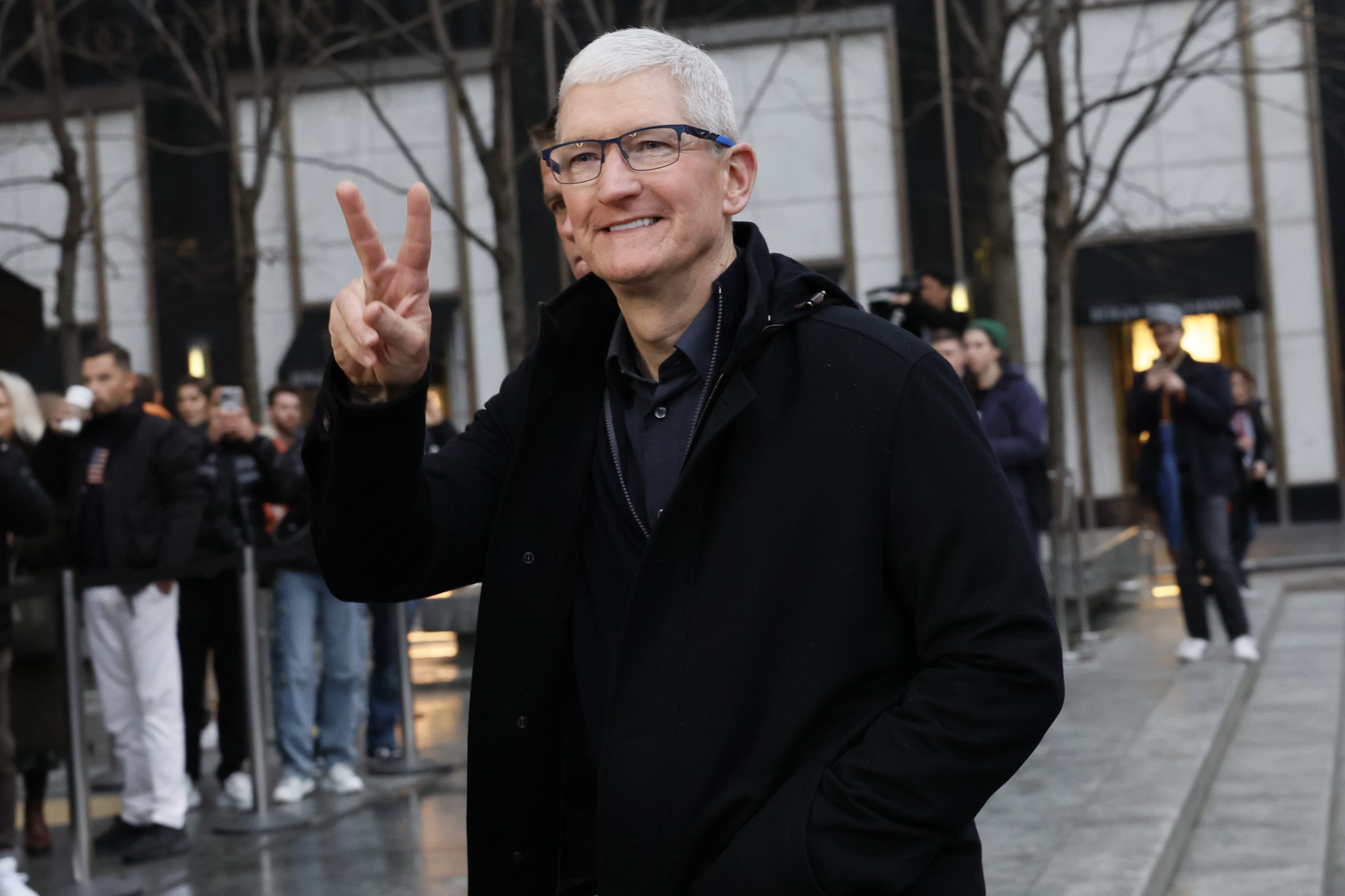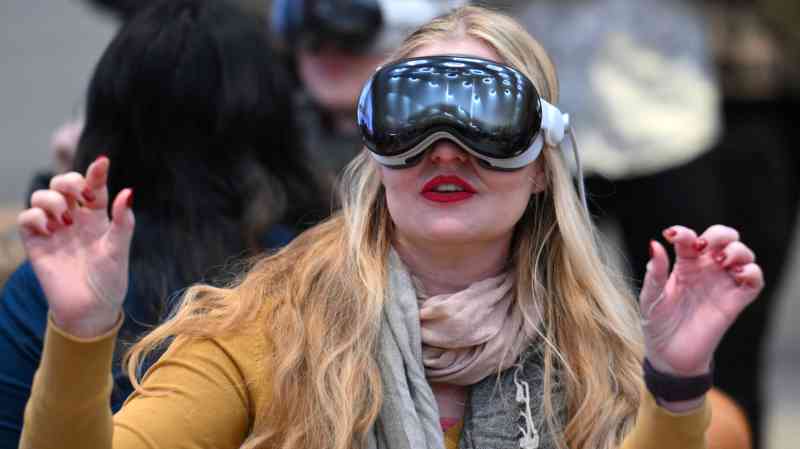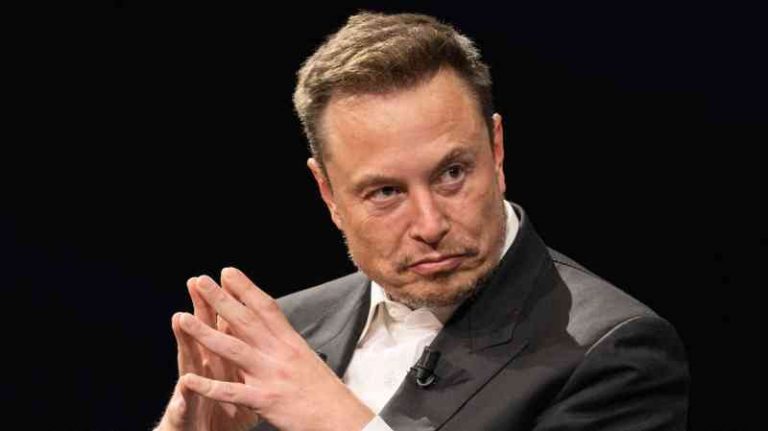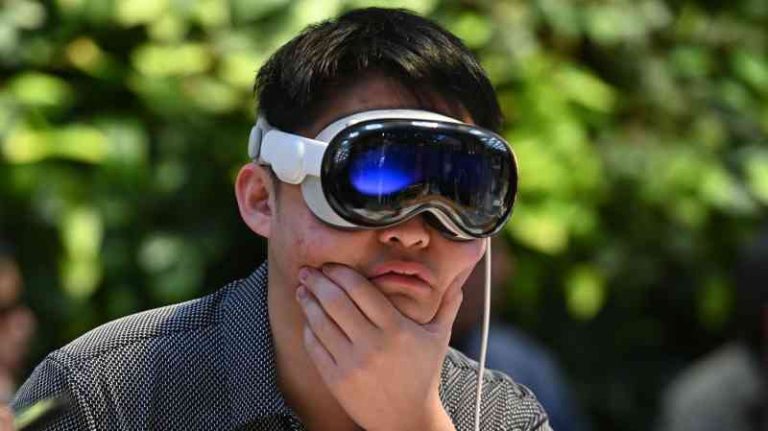Apple’s Vision Pro headset is mind blowing. But will it really catch on?
Eight months ago, Tim Cook unveiled the Apple Vision Pro, a $3,500 face-computer haughtily proclaimed by Apple’s chief executive to be “the most advanced personal electronic device ever”.
It hit the shelves in America last week, sparking a downpour of (mostly fawning) reviews. Having tried it myself, one thing is inarguable: using the Vision Pro is a bewildering experience in every respect.
That starts with its presentation. After an iPhone camera is used to calibrate the size and shape of one’s face, the ski-goggle-style headset is fitted with a set of seals to keep light out and ensure optimal fit.
Moments later, an Apple store employee materialises in blue latex gloves and presents, with the solemnity of someone transporting the crown jewels, a sculpted tray that cradles the device. What follows is a half-hour demonstration where I am walked through how to use my eyes, hands and voice to control a device that projects apps, stunning immersive video and photographs onto the wearer’s field of view. The Vision Pro is a stunning technological achievement, of which more shortly.
But it also faces immense obstacles to Apple’s lofty aim of creating an entirely new industry of “spatial computing”. The stakes are very high. Meta has famously spent more than $46 billion (£36.5 billion) on building the metaverse, an immersive digital world to which access can be gained through its rival headset, the Meta Quest. More than a decade since the first version was released, however, it remains a niche product used mostly by gamers.
The most obvious barrier to Apple’s new gadget is the price. At $3,500, the Vision Pro is simply too expensive except for the biggest, and most well-heeled, among Apple’s super-fans. The Meta Quest, by comparison, costs $500.
A price tag of $3,500 demands a mind-blowing experience — a sense that a new technological frontier has been opened. On that score, Apple has done well. For one thing, the eye-tracking is spookily accurate. As I gaze at the apps floating in front of me, the one I focus on is highlighted. Pinch the air where that highlighted app is, and it opens.
The most jaw-dropping experiences, however, are of the “immersive” videos made especially for the Apple Vision Pro. Before I click (pinch?) on it, the Apple employee reads a script that sounds a bit like a pre-flight safety briefing. I quickly understand why, as I am suddenly placed on a vertiginous cliff next to a mountain climber. I am then engulfed by turquoise water, surrounded by great white sharks, after which I am floating in a hot air balloon. Looking down inspires a drop in the stomach; a pang of nausea strikes. The sensory experience of being suddenly and viscerally somewhere else, as I sit on a stool in an Apple store, is unsettling.
James Cameron, the director of the film Avatar, told Vanity Fair magazine that the Vision Pro was “revolutionary” and would transform the entertainment landscape. Others have been more circumspect, with both YouTube and Netflix pointedly declining to make their services available on it. Ted Sarandos, Netflix’s co-chief executive, explained last month: “The device is so sub-scale that it’s not really particularly relevant to most of our members.”
When the demo is over, I take off the headset — and the most immediate sensation is, oddly enough, relief, not unlike when you get off a rollercoaster and have a new-found affection for solid ground.
And this is something that Cook & co have to address. The Vision Pro is an expensive joy ride. It is not clear what problem Apple is solving, and what will inspire hundreds of millions of people to buy the device.

Whether Apple can pull it off will hinge on its ability to persuade software developers to make apps for the Vision Pro. These are the same developers that for years have groused about Apple’s treatment of them — about the 30 per cent commission it rakes in on in-app purchases and has become the centrepiece of multiple antitrust lawsuits around the world.
The iPhone example, however, is instructive. It was not until Apple opened the App Store, a year after it launched the iPhone, that the device transformed from just another phone into the taxi-hailing, food-ordering, social media hub to rule them all. It now offers nearly two million apps that together comprise their own micro-economy.
Apple launched the headset with 600 apps — not a lot, but more than the 570 or so that the Meta Quest App Store offers, despite a headstart of several years.
By 2030, Gene Munster of the Minnesota-based Deepwater Asset Management predicted, the Vision Pro will account for 15 per cent of Apple’s global revenue — but he acknowledged that it has a very long way to go: “I have this sinking feeling that I just spent $3,800 [$300 tax added to the retail price] on a device that is going to have pretty limited utility over the next one to three years.”
Indeed, the in-store demo encapsulates the challenge — devoting half an hour to teaching people how to use the device is a labour-intensive sales strategy. Another problem is the weight of the Vision Pro: 20 ounces. After that half-hour, I was very happy to get the technology, which left a bright pink crease across my forehead, far away from my face.
The biggest question, however, is whether this is the tech the world wants — or needs. Its release came in the same week in which the chief executives of the top social media companies were hauled before Congress to account for the role their technology plays in a terrifying catalogue of online harms to young people, from bullying to loneliness.
The Vision Pro is genuinely impressive — the product of more than 5,000 patents, billions of dollars of investment and seven years of toil. And yet, to put it on is to put a screen between yourself and the world. Apple unwittingly highlighted this reality in part of the demo, which revolves around a three-dimensional video of a child’s birthday.
The picture is so crisp, the spatial audio so adept at matching sounds and voices to the scene, that it feels like you are actually there — that you can reach out and touch it. And yet, you can’t. The result is a strange sense of melancholy, of unbridgeable distance. You’re a ghost.
No such sensations occur to Cook, who rhapsodised about the day he spent at an Apple store last week watching consumers doing their demos with the device. “People had tears in their eyes,” he wrote. “Our mission is to enrich people’s lives, and I could feel that happening in real time. What a day!”






